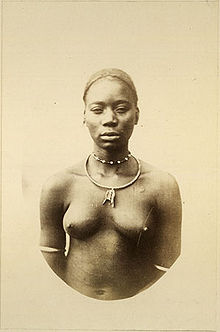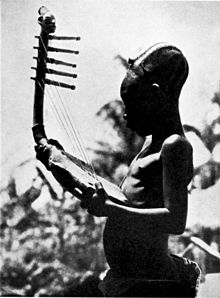- Mangbetu people
-
The Mangbetu are a people of the Democratic Republic of the Congo, living in Orientale Province. The majority live in the villages of Rungu, Poko, Watsa, Niangara, and Wamba.
Contents
Language
The language is Mangbetu, called Nemangbetu in their language and Kingbetu in the national language of Lingala. Mangbetu is a member of the Nilo-Saharan language group. The Mangbetu language is phonetically distinct from other languages in that it possesses both a voiced and a voiceless bilabial trill. [1] The Labo language of Vanuatu, also known as Mewun, is the only other language known to possess this phonetic feature. [2].
Culture
The Mangbetu are known for their highly developed art and music. One instrument associated with and named after them is the Mangbetu harp or guitar. See [3] and. [2] for images. One harp has sold for over $100,000.[4]
Musicologists have also sought out the Mangbetu to make video and audio recordings of their music.[5]
The Mangbetu stood out to European explorers because of their elongated heads. Traditionally, babies' heads were wrapped tightly with cloth in order to give them this distinctive appearance. The practice began dying out in the 1950s with the arrival of more Europeans and westernization. Because of this distinctive look, it is easy to recognize Mangbetu figures in African art.
History
Prof. Peter J. Bloom in his book entitled French colonial documentary: Mythologies of Humanitarianism stated, "However, it is part of an open text in which the lineage of the Mangbetu has been traced to Egypt, particularly to the ancient Egyptian iconography of Nefertiti." [6] By the early 18th century they consisted of a number of small clans who, from southward migrations, had come in contact with a number of northward-migrating Bantu-speaking tribes among whom they lived interspersed. In the late 18th century a group of Mangbetu-speaking elites, mainly from the Mabiti clan, assumed control over other Mangbetu clans and many neighboring Bantu-speaking tribes. It is likely that their knowledge of iron and copper forgery, by which they made weapons and fine ornaments, gave them a military and economic advantage over their neighbors. [7].
The question of cannibalism
Many recent studies feature the Mangbetu as a historically cannibalistic people. According to Mangbetu men interviewed in the documentary Spirits of Defiance: The Mangbetu People of Zaire it appears that many Mangbetu currently believe their ancestors to have practiced cannibalism. [8] David Lewis asserts that a "wave of flesh-eating that spread from inveterate cannibals like Bakusa to Batetela, the Mangbetu, and much of the Zande" resulted from ongoing political disorder caused by Swahili raids in the 1880s. However, Keim contends that many of the accounts of cannibalism are not based on "careful fieldwork in Africa but on nineteenth-century European accounts that were deeply prejudiced by Dark Continent myths."
References
- ^ Linguist Wins Symbolic Victory for 'Labiodental Flap'. NPR (2005-12-17). Retrieved on 2010-12-08.
- ^ LINGUIST List 8.45: Bilabial trill. Linguistlist.org. Retrieved on 2010-12-08.
- ^ Arched harp (donnu) by Mangbetu people, Belgian Congo, ca. 1910–1920, at the National Music Museum. Usd.edu (2010-10-05). Retrieved on 2010-12-08.
- ^ [1][dead link]
- ^ L'orchestre Mangbetu (1954), IMDB.com
- ^ French Colonial Documentary: Mythologies of Humanitarianism (9780816646296): Peter J. Bloom: Books. Amazon.com. Retrieved on 2010-12-08.
- ^ Mangbetu People. Uiowa.edu (1998-11-03). Retrieved on 2010-12-08.
- ^ Mangbetu. YouTube. Retrieved on 2010-12-08.
Further reading
- Christopher Ehret, The Civilizations of Africa: A History to 1800 (University of Virginia Press, 2002), 436–438.
- Curtis A. Keim, Mistaking Africa: Curiosities and Inventions of the American Mind (Basic Civitas Books, 1999), 42–43, 92–93.
- David Levering Lewis, The Race to Fashoda: European Colonialism and African Resistance in the Scramble for Africa (New York: Weidenfeld and Nicolson, 1987).
Categories:- Ethnic groups in the Democratic Republic of the Congo
Wikimedia Foundation. 2010.


